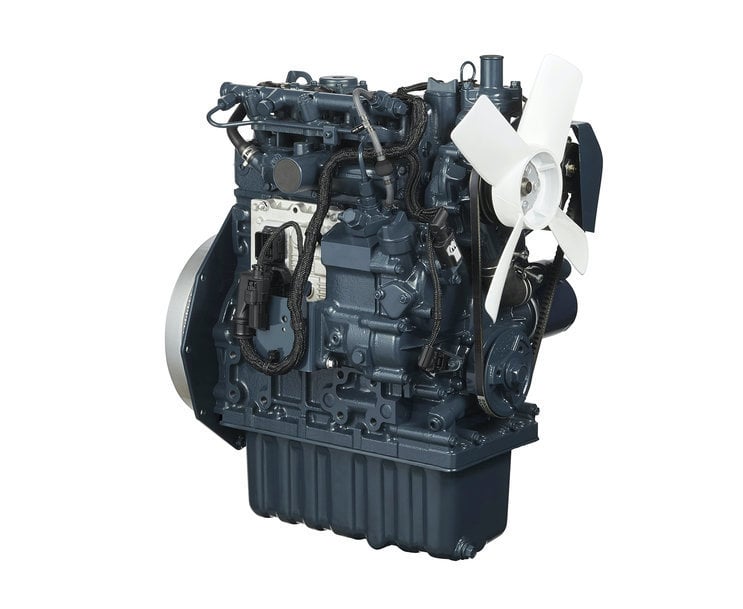Development of the D1105-K Electronically-Controlled Small Industrial Diesel Engine
Building Off the D902-K to Broaden the Kubota Lineup of Electronically-Controlled Small Engines Using the TVCR Unique Combustion System.

D1105-K Electronically-controlled Small Industrial Diesel Engine
Kubota Corporation developed the D1105-K electronically-controlled small industrial diesel engine (displacement of 1.123 L; hereinafter “D1105-K”) as a power source complying with the latest European, American, and Chinese emission regulations. The engine adopts the unique Kubota TVCR combustion system to realize both greater fuel efficiency and a compact size that makes it easy to use as a replacement to conventional Kubota engines. Kubota will contribute to a carbon-neutral society by expanding an engine lineup that can reduce CO2 emissions.
1. Development Background and Objectives
- Kubota has been responding to the diverse needs of construction and industrial machine manufacturers throughout the world, including compliance with the latest emission regulations in each country. These efforts have earned the company the top global market share*1 in diesel engines under 100 horsepower for industrial use.
- Stricter emission regulations not only in Europe but the rest of the world are currently driving decarbonization needs. The electronic control of engines finely tunes fuel injection to better fuel efficiency than conventional mechanical engines, which should reduce CO2 emissions and make exhaust gas cleaner. For these reasons, Kubota has been striving to broaden its electronically-controlled small engine lineup.
- However, swapping out a mechanical engine with an electronically-controlled engine generally requires numerous other components for the electronic control. These extra parts require more space to mount the engine, which can entail a large number of design changes to the main machine.
- The D1105-K takes advantage of an electronic control system optimized specifically for small engines alongside the TVCR combustion system that combines Kubota’s unique combustion and fuel technologies.
- The D1105-K is equipped with the TVCR combustion system, which combines our original combustion system with a unique electronic control technology developed specifically for small engines.
- The development maintained the same size as a mechanical engine with equivalent output while realizing an electronically-controlled engine with great fuel efficiency and exhaust gas so clean that there is no visible black smoke.
- In addition to complying with emission regulations worldwide, the D1105-K complies with the strictest China's national smoke regulations, Category Ⅲ. Moreover, manufacturers can directly mount the ECU*3 to the engine to reduce the burden on the machine design when swapping out the engine, which is expected to reduce the length of development.
- Kubota will contribute to realizing a carbon-neutral society by bolstering its lineup of not only electronically-controlled large engines already underway but also electronically-controlled small diesel engines.
1. Based on internal research (2020 Power Systems research 〔PSR〕 Survey)
2. Regulations in China for black smoke emissions for non-road vehicles
3. The Electronic Control Unit (ECU): An electronic device to optimally control fuel consumption, fuel injection pressure, timing, and cycle according to operation conditions
2. Features
Suppress black smoke
The D1105-K eliminates visible black smoke emissions often produced when starting, accelerating, or suddenly applying load to an engine. This new engine complies with the strictest China's national smoke regulations, Category Ⅲ.
Low-fuel consumption
The D1105-K is equipped with the TVCR combustion system, which combines our original combustion system with a unique electronic control technology developed specifically for small engines.
These innovative technologies improve fuel consumption by roughly 5% compared to conventional models.
Acquisition of engine operating data, improvement in drivability and work efficiency
The electronic control enables use of the CAN*4 communication protocol, which can control engine rotation and torque through signals sent from the vehicles. The CAN also enables the collection of the engine drive data necessary for telematics technology. This data improves drivability and operational efficiency by aggregating the torque characteristics that mechanical control cannot realize to reduce rotation speed under sudden load.
Enhanced compatibility
Manufacturers can easily replace conventional mechanical engines with the D1105-K because specifications, such as the exterior dimensions as well as the position of the intake and exhaust and power take-off, stay the same. It can also reduce the extra labor placed on the design of the main machine generally necessary to install an engine with an electronic control unit, such as designing the installation position and harnesses, because the ECU is mounted directly to the engine.
Improved serviceability
Use of a large oil pan extends the period between essential regular oil changes up to 500 hours*5. Better serviceability reduces the time required for engine maintenance.
4. controller Area Network (CAN): A global serial communication bus standardized by the ISO that allows microcontrollers and devices to communicate with one another without a host computer.
5. Performance varies according to the operation conditions.
6. Product Outline
3. Product Outline

Reference:
The First Electronically-Controlled Small Industrial Diesel Engine from Kubota
https://www.kubota.com/news/2021/20210324.html
www.kubota.com

